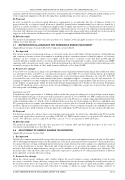Page 1135 - SAIT Compendium 2016 Volume2
P. 1135
EXPLANATORY MEMORANDUM ON THE TAXATION LAWS AMENDMENT BILL, 2015
again precluded from bene ting from the incentive as the manufacturer would neither be letting the manufacturing assets to the components supplier nor be directly using those manufacturing assets in a process of manufacture.
III. Proposal
In order to adapt the accelerated capital allowances requirements to accommodate this type of business model, it is proposed that the accelerated capital allowances should be granted where manufacturing assets that are owned by a taxpayer are made available to a components supplier under a supply agreement for no consideration for the bene t of the manufacturer’s processes. In order not to nullify the current provisions of section 23A, which governs the limitation of section 12C allowances in respect of rental manufacturing assets, the proposed incentive will only be for the bene t of taxpayers in the Automotive Industry who receive grants as contemplated in the Eleventh Schedule.
IV. Effective date
The proposed amendments will come into operation on 1 January 2016 and apply in respect of years of assessment ending on or after that date.
4.7 DEPRECIATION ALLOWANCES FOR RENEWABLE ENERGY MACHINERY
[Applicable provisions: Sections 12B(1)(h)(ii) and new section 12B(2)]
I. Background
The current and projected national shortage of electricity in the foreseeable future will inconvenience South Africans and constrain economic activity. Government is working on short- term interventions to limit the impact of electricity shortages on the economy, to ensure scarce supply can be directed to economic sectors that drive growth and job creation. Initiatives include efforts to encourage investment in cleaner energy forms to reduce our greenhouse gas (GHG) emissions and to broaden our energy sources. Current legislation does allow for accelerated depreciation allowances for renewable energy in the forms of solar, wind, biomass and hydro of less than 30 MW.
II. Reason for change
Solar is however classi ed as a single concept within the current legislation without delineating it into its different forms e.g. solar photovoltaic (solar PV) or concentrated solar power (solar CSP). To accelerate and incentivise development of solar PV, there is consideration to further enhance the accelerated depreciation allowance for solar PV. Solar PV is favoured because of its low environmental and water consumption impact, economies of scale and ef ciencies of learning accumulated over time within the South African solar PV renewable energy industry. This has led to an increase in the number of applications within the Renewable Energy Independent Power Producers Procurement Programme for solar PV which also led to a decrease in the average bidding price whilst the average size of projects has also been increasing with each bidding round.
Embedded solar PV
Consultations with representatives of Industry indicated that the proposed enhanced accelerated depreciation impact would be minimal on large-scale projects with a generation capacity of over 1 000 kW or 1 MW compared to the small- scale embedded solar PV projects. This is because large-scale solar PV projects require supporting infrastructure like roads, transmission lines etc. which can be excluded from the asset base for taxation purposes. However, embedded solar PV generation does not require such infrastructure hence is better placed to bene t from the accelerated depreciation incentive. Therefore it is proposed to improve the current incentive to increase uptake of small-scale embedded solar PVs to ease the pressure off the national electricity grid as the embedded solar PV generators become energy self-suf cient.
III. Proposal
It is therefore proposed to enhance the accelerated depreciation incentive for small scale embedded solar PV renewable energy with a generation capacity not exceeding 1 000 kW or 1 MW from the current 3 year period (50% allowance in year 1; 30% allowance in year 2 and 20% allowance in year 3) to a 1 year period of 100% allowance.
IV. Effective date
The proposed amendments will come into operation on 1 January 2016 and will apply in respect of the years of assessment commencing on or after that date.
4.8 ADJUSTMENT OF ENERGY SAVINGS TAX INCENTIVE
[Applicable provision: Section 12L]
I. Background
In 2009, Government announced the energy ef ciency savings tax incentive and implementation took place in November 2013 following promulgation of the relevant regulations. Section 12L makes provision for taxpayers to claim an allowance for energy ef ciency savings resulting from investments in energy ef ciency measures and process adjustments deemed to be in the production of income. The main aim of this incentive is to encourage the uptake of energy ef ciency measures that result in improvements in energy use and contribute towards reduced greenhouse gas emissions. The monetary value of the allowance that can be claimed by taxpayers is calculated at 45 cents per kilowatt hour or kilowatt hour equivalent of energy ef ciency savings.
II. Reasons for change
Given the current energy challenge and to further address the need to improve energy consumption, it has become necessary to revisit the energy ef ciency savings rates. Industry has raised concerns regarding the actual bene t value of the incentive in the rst year of operation as it relates to both the high upfront costs of capital and, possibly, compliance costs incurred in the measurement and veri cation of savings to obtain an energy ef ciency savings certi cate as
SAIT CompendIum oF TAx LegISLATIon VoLume 2 1127


